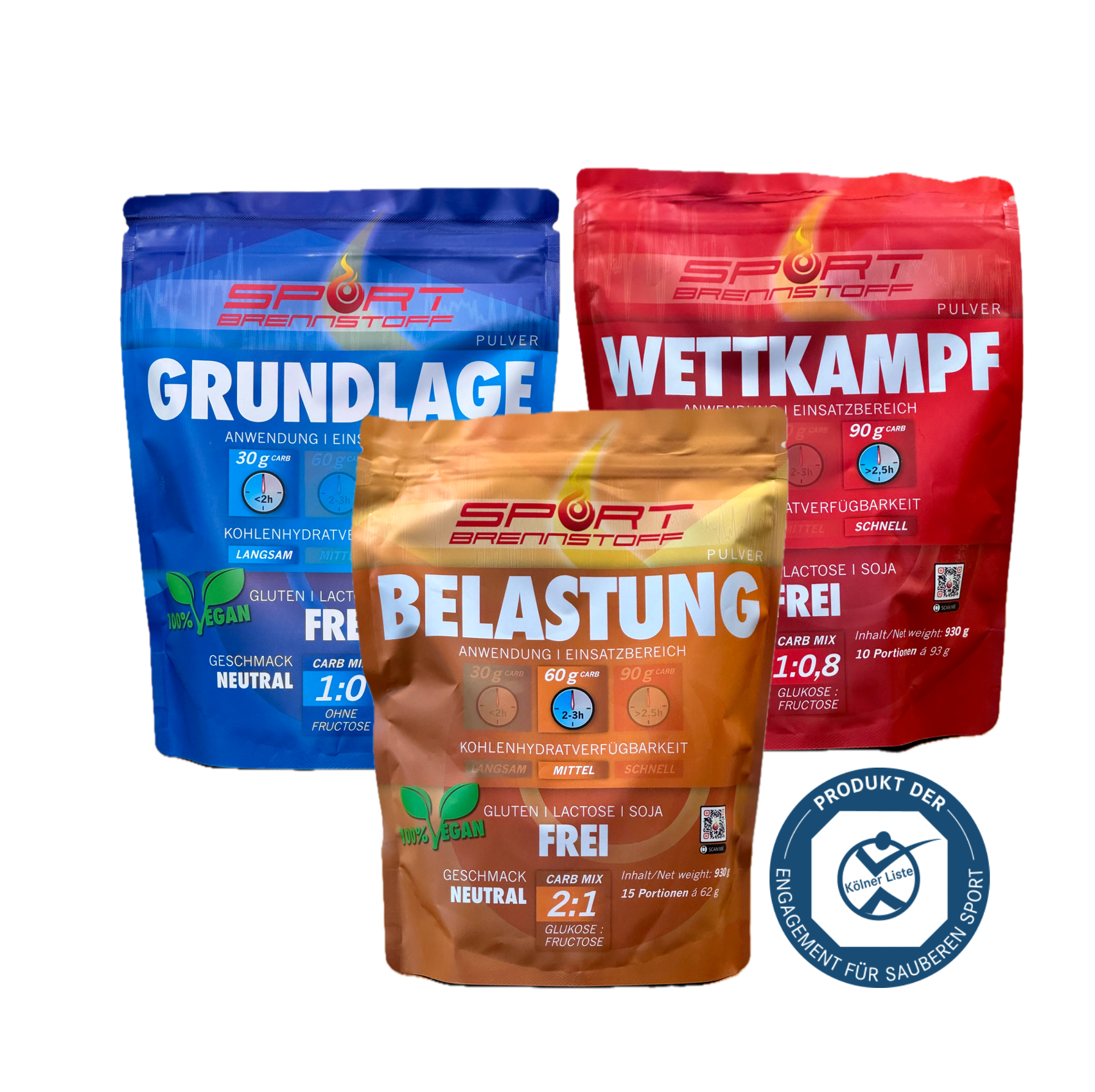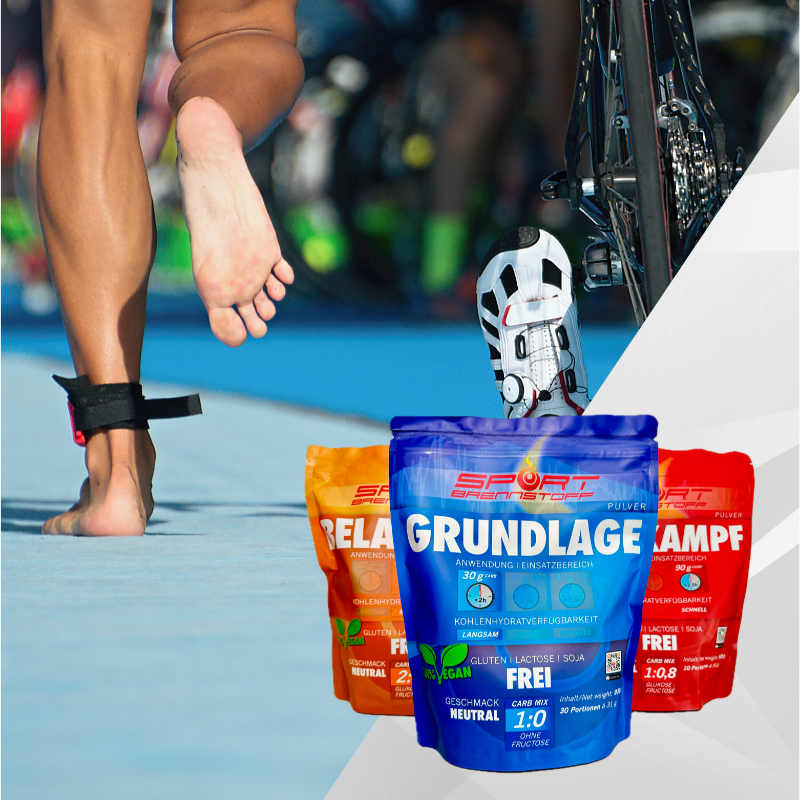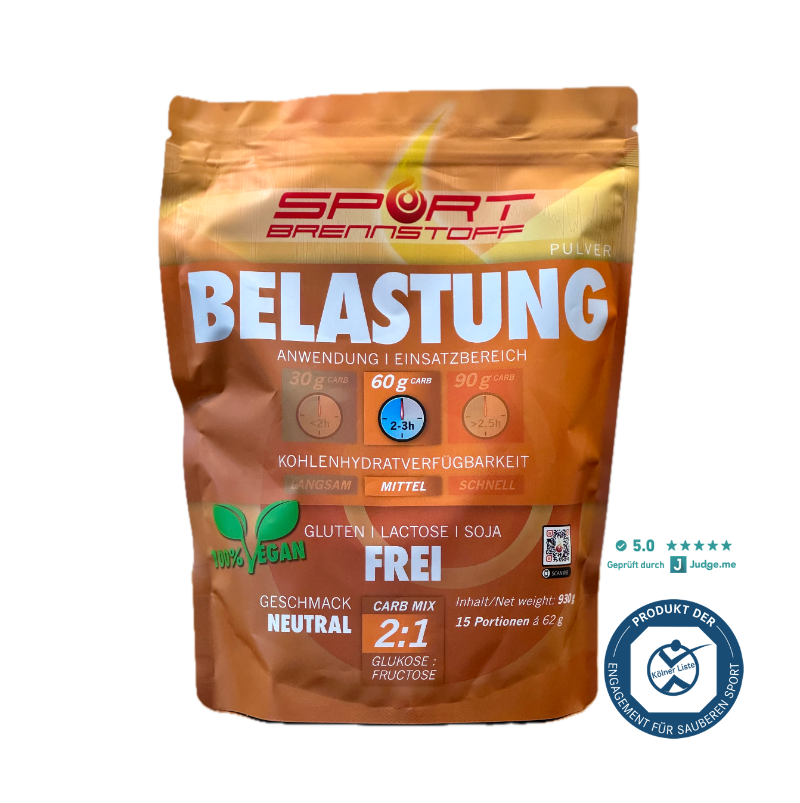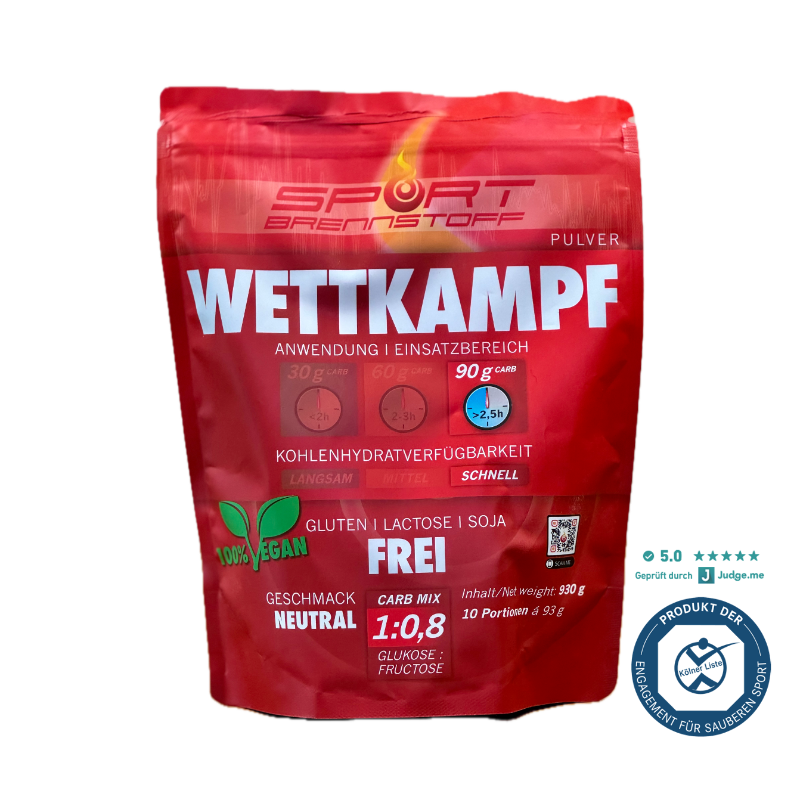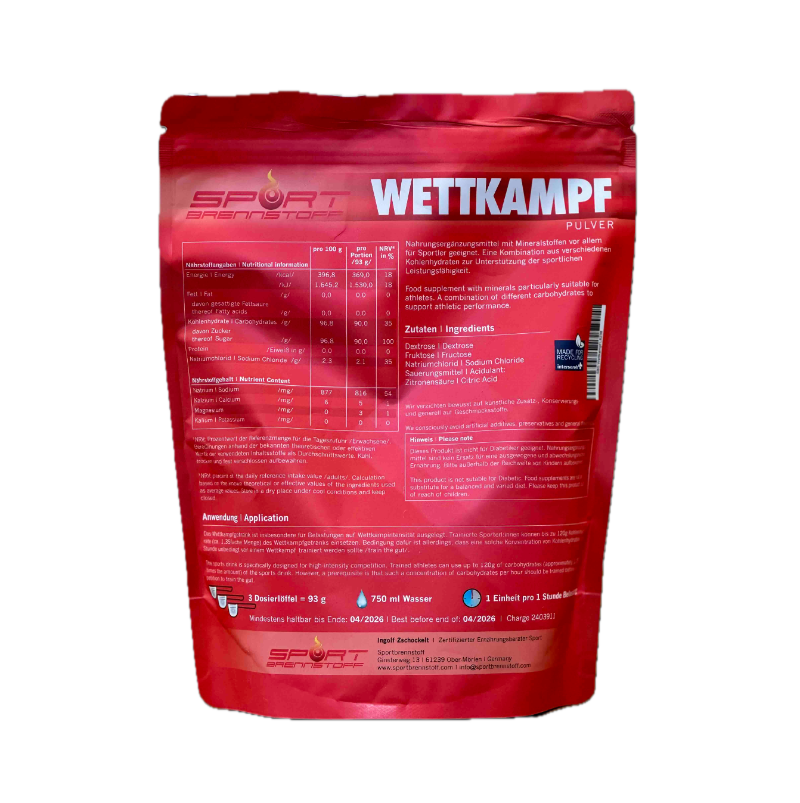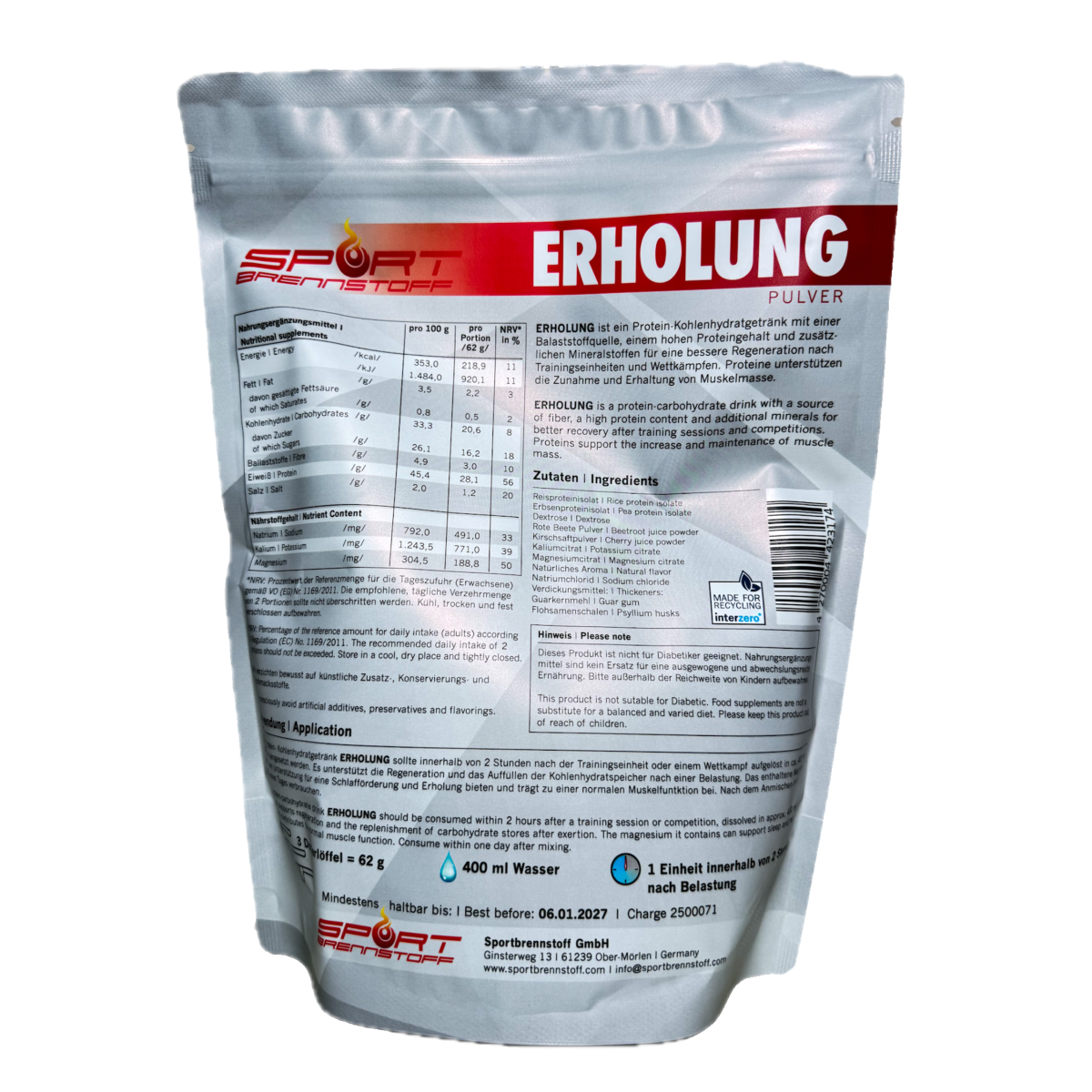Ich bin begeistert, Geschmack und Konsistenz sind top. Ich werde es wieder kaufen!
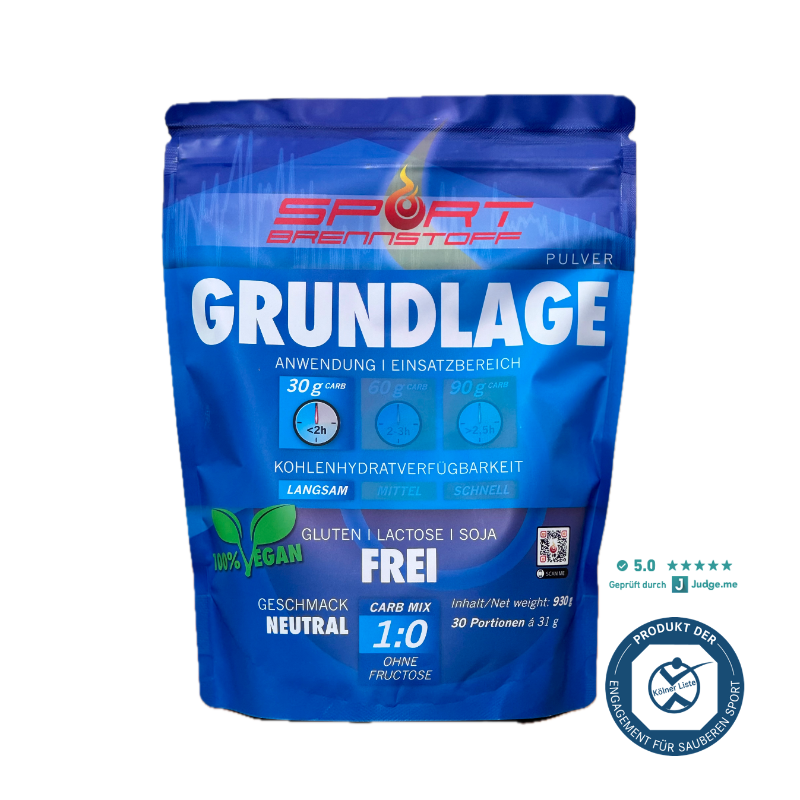
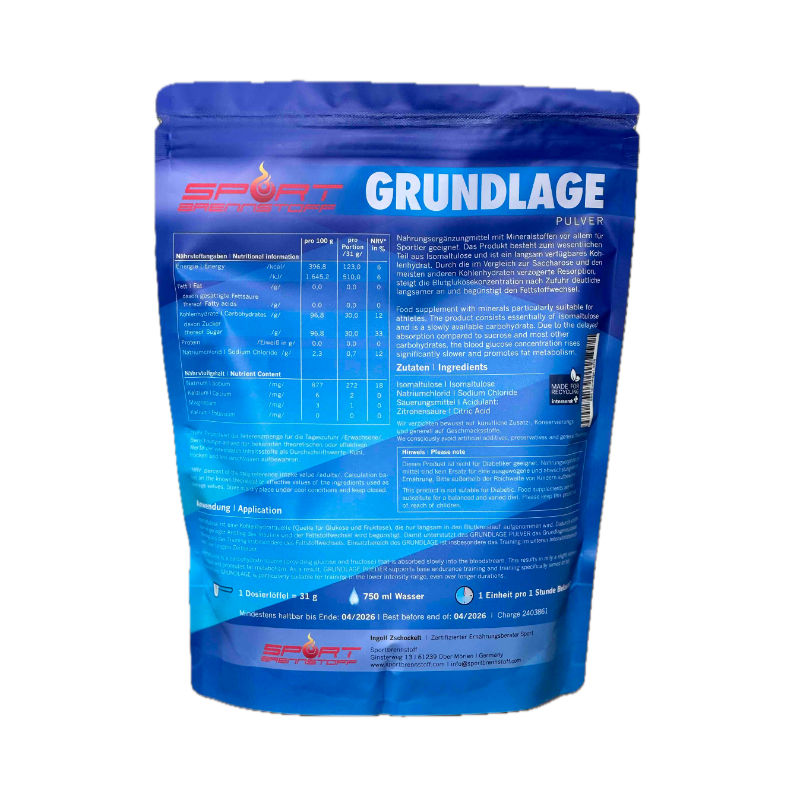
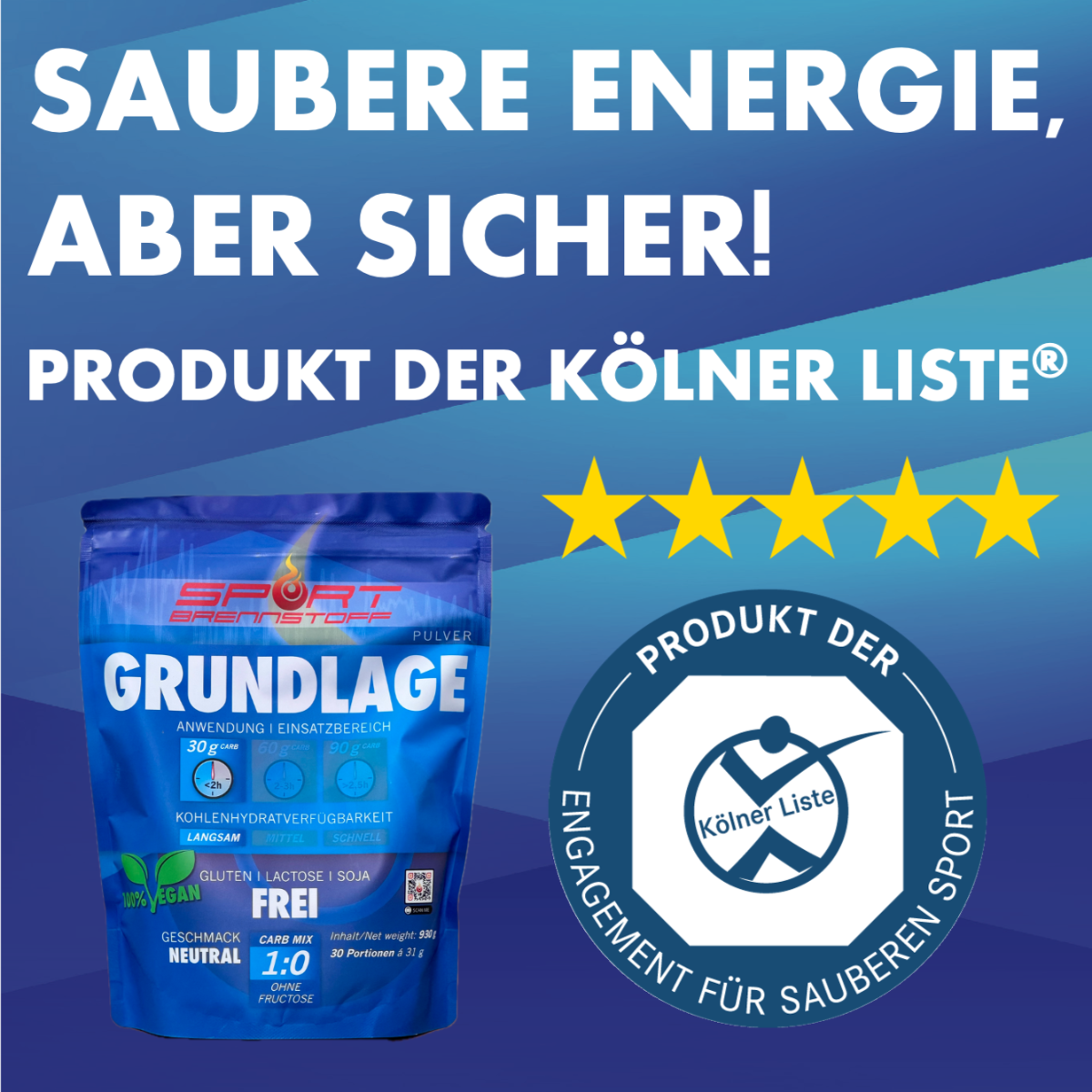
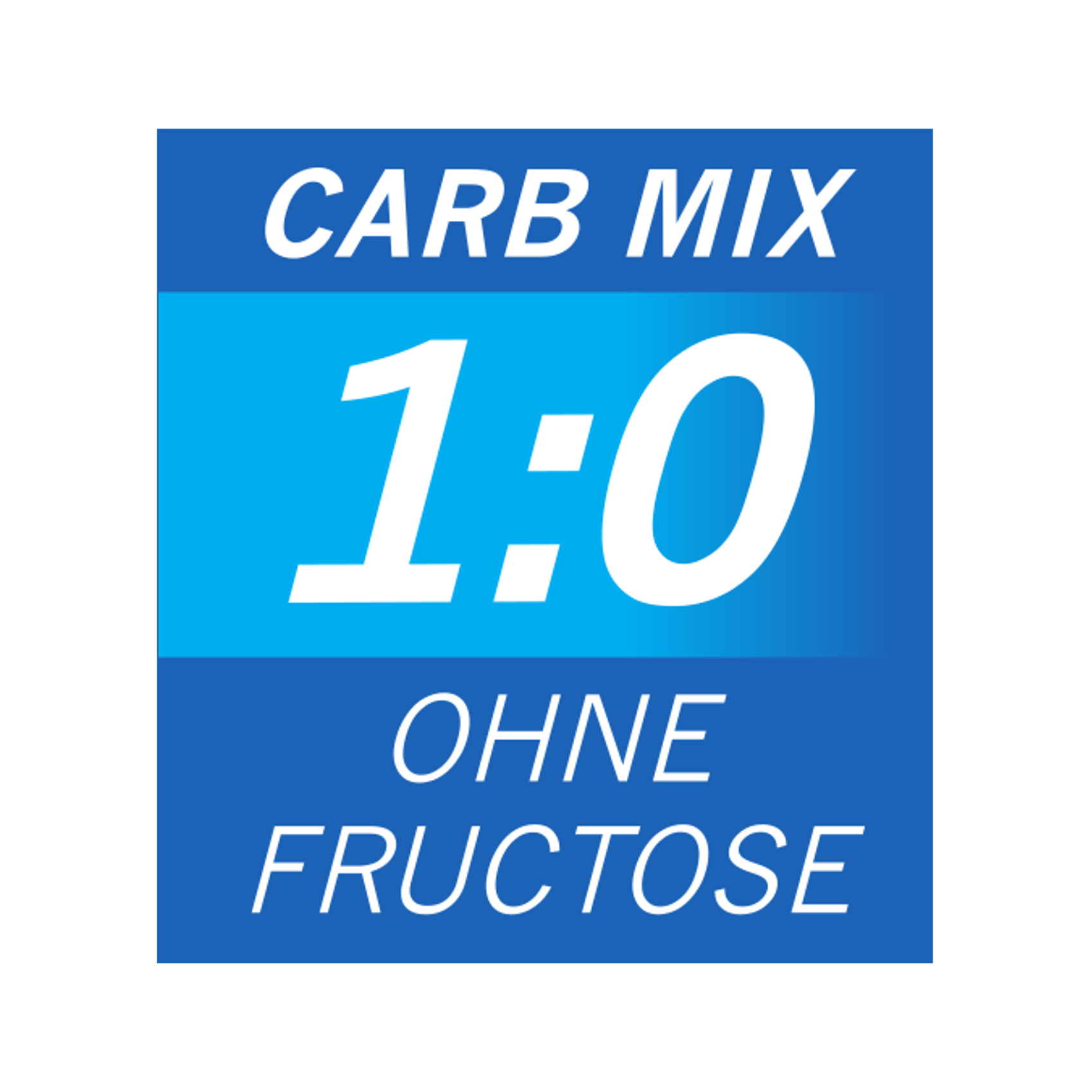
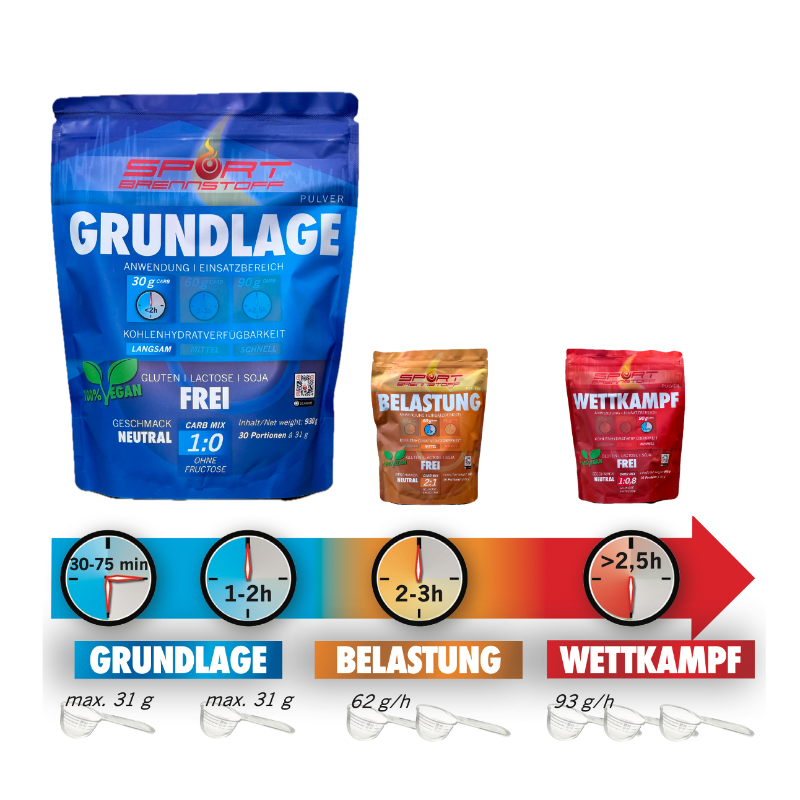
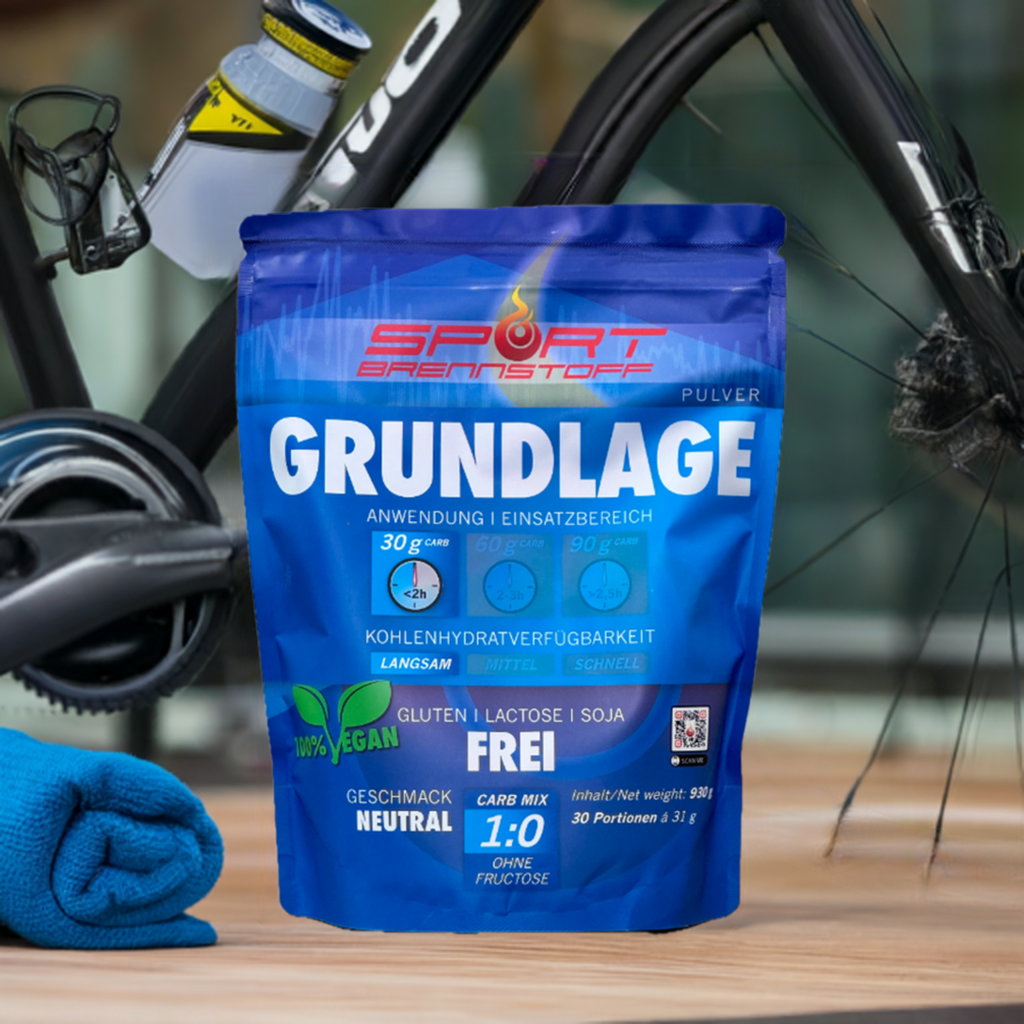
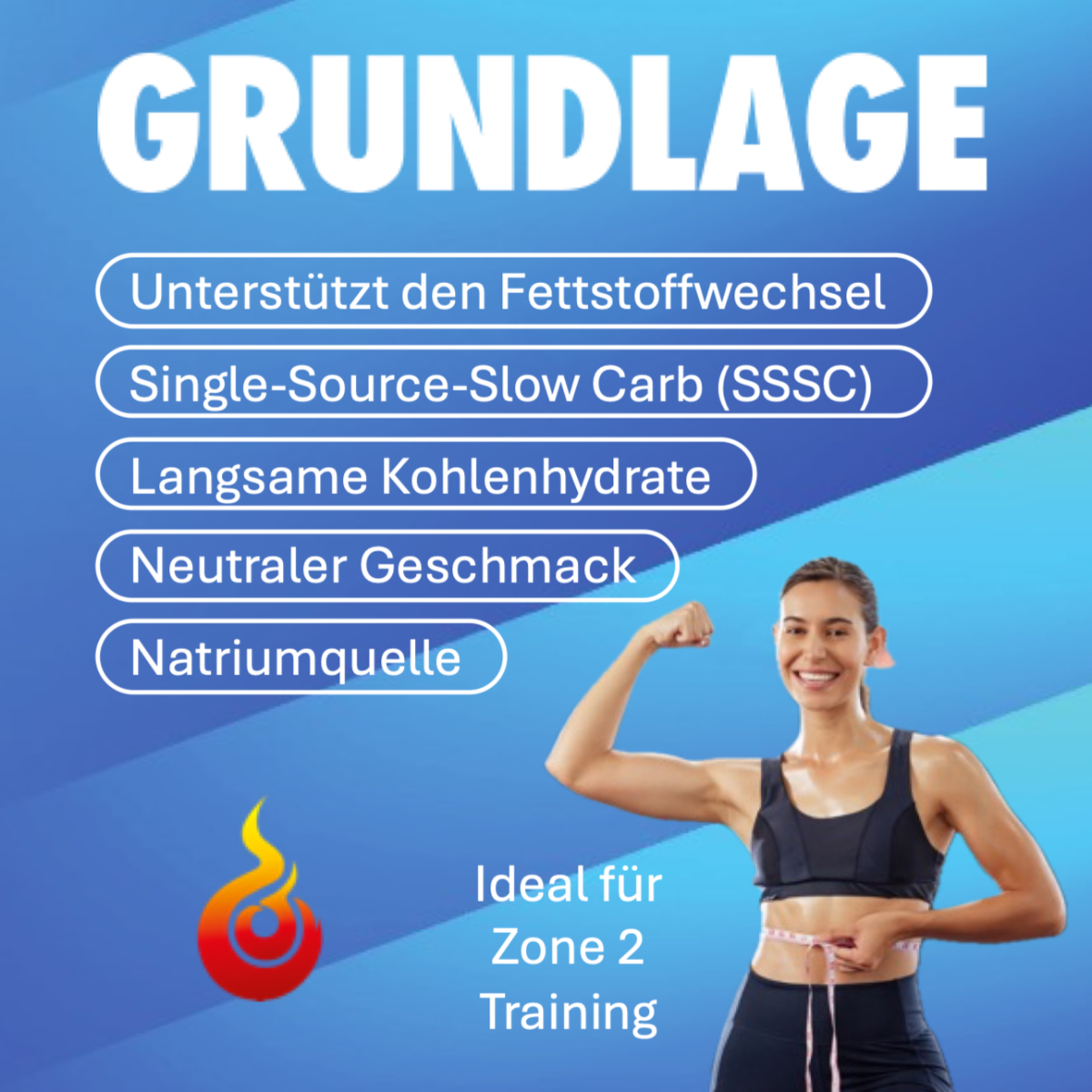
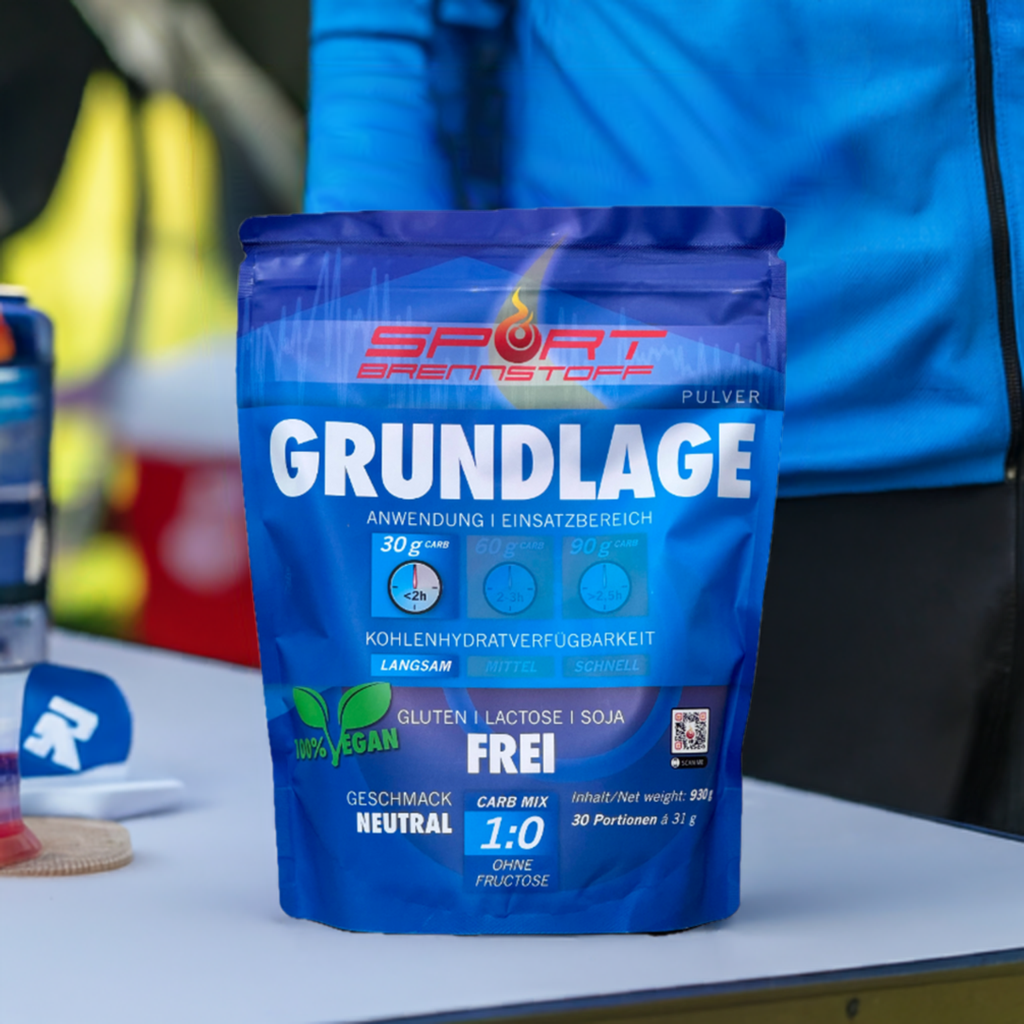
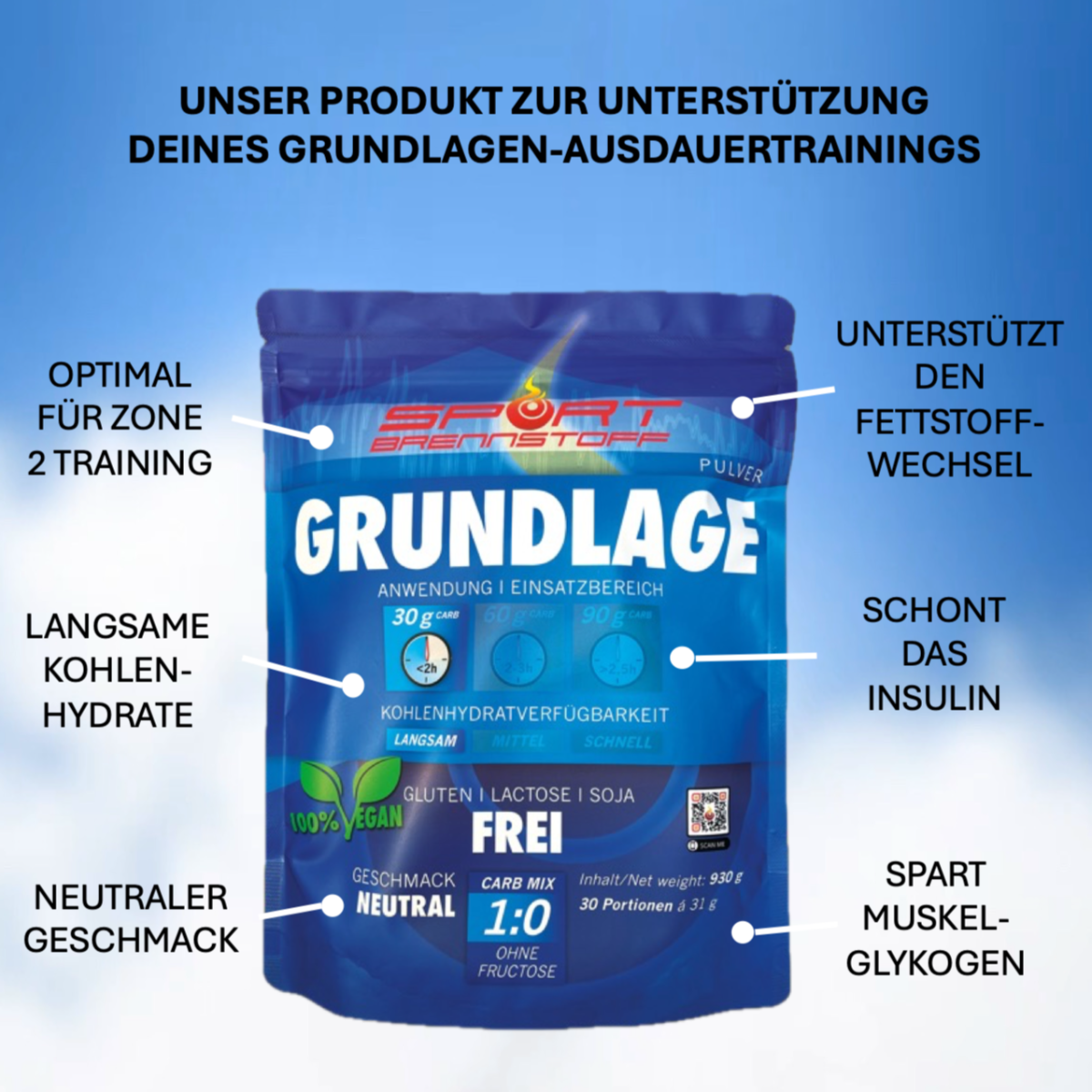
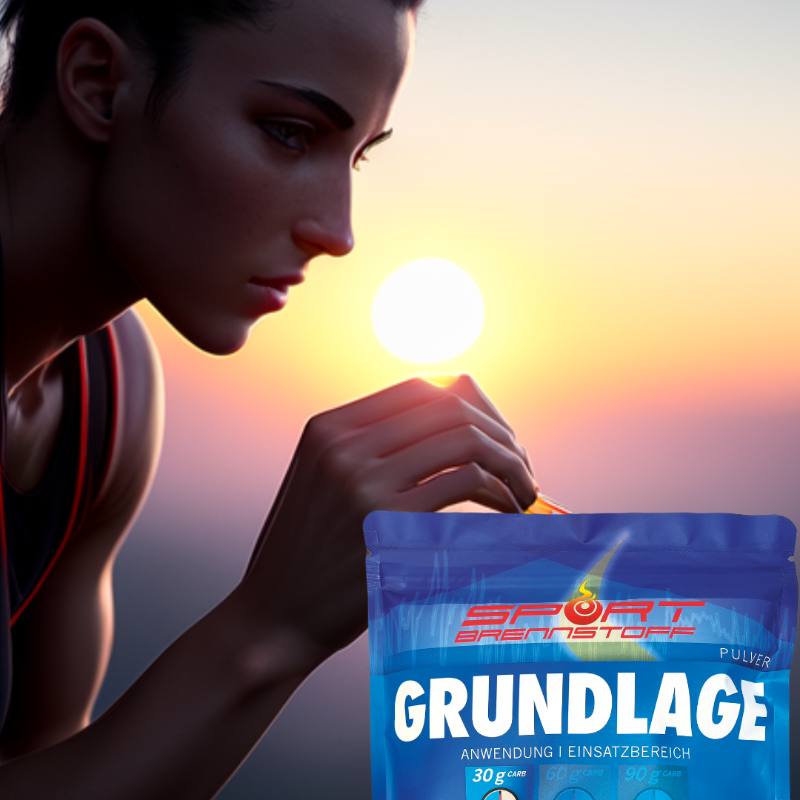

SportBrennstoff GRUNDLAGE
- Slow KH as a Single-Source Carb
- Supports fat metabolism
- Isotonic sports drink with carbohydrates in 750ml
- Provides you with 30g of carbohydrates per hour (max. 60g)
- Easy to use, precisely dosed
- Neutral, natural "original" taste
- Content: 930g I 30 portions of 31g each
Safe shopping with many options
-
Free shipping from €60
-
Fast shipping / delivery within approx. 3 working days
-
Our contribution to protecting the environment.
-
Cologne List© - our voluntary commitment to clean sport.

Product information
SportBrennstoff GRUNDLAGE: Your ideal sports nutrition
|
SportBrennstoff GRUNDLAGE is the solution for everyone who values efficient basic training. Developed as a natural and optimized sports nutrition, this product is ideal for athletes who want to maximize their training effect in the basic area, also known as Zone 2 training. |
|
The heart of SportBrennstoff GRUNDLAGE is the unique Single Source Slow Carb (SSSC), in the form of isomaltulose (Palatinose™). This carbohydrate source is absorbed extremely slowly into the bloodstream, which means that insulin levels only rise minimally. This ensures that fat metabolism is optimally supported during training and is not disrupted. |
|
In addition, the mixture is supplemented with the sodium source sodium chloride 🧂 and citric acid 🍋. These ingredients improve tolerance, the supply of necessary sodium and help maintain energy levels during longer training sessions. |
|
SportBrennstoff GRUNDLAGE not only provides you with the energy you need for longer training sessions, but also reduces the feeling of strain. Enjoy training with high tolerability and secure the advantage of sports nutrition that is perfectly tailored to your needs. |
_____
Vegan – Suitable for vegans, but not independently certified as such
Vegetarian – Suitable for vegetarians, but not independently certified as such
Gluten-free – Gluten-free, but not independently certified as such
GMO-free - GMO-free, but not independently certified as such
Dairy-free – Dairy-free, but not independently certified as such
Egg-free – Egg-free, but not independently certified as such
Celery Free – Celery free, but not independently certified as such
Sesame Free – Sesame free, but not independently certified as such
Soy-free – Soy-free, but not independently certified as such
Wheat-free – free from wheat, but not independently certified as such
This product is not suitable for diabetics. Food supplements are not a substitute for a balanced and varied diet. Please keep out of the reach of children. The acidifier is citric acid (E330), which is included at 2% per portion (i.e. 0.6g per portion).
We accept our responsibility to preserve biodiversity and protect our environment. To this end, we have implemented the following initiatives:
1. Complete compensation of CO2 emissions from the shipping process together with Deutsche Post / DHL .
2. Participation in the complete recycling process for our packaging together with the Green Dot.
3. We plant trees and care for trees with our active participation in cooperation with sie kam sah und säte!
Cologne List® - our voluntary commitment to clean sport - Our product SportBrennstoff GRUNDLAGE is on the Cologne List® for products with a minimized doping risk.
_____
The Cologne List® is an initiative for doping prevention and lists nutritional supplements (NEM) that have been tested for selected doping substances by a laboratory that is a world leader in NEM analysis for doping substances.
_____
As a partner of the Cologne List®, we ensure greater transparency in a very heterogeneous market and support athletes, teams, clubs and associations in assessing these products.
_____
The Cologne List® is not only an indispensable partner in elite and competitive sports, but also for recreational and amateur athletes, because who would want to use products that may contain banned substances and thus pose a health risk?
Advantages
Supportive
Supports fat metabolism, especially during Zone 2 training (basic training) - the foundation for performance development.
SSSC
Single-source slow carb means only one carbohydrate source for extra slowly available carbohydrates and optimal tolerability.
Neutral
Neutral taste for improved tolerance and without artificial additives or flavors.
Isotonic
Carbohydrates and sodium source mixed with 750ml of water make an isotonic drink.
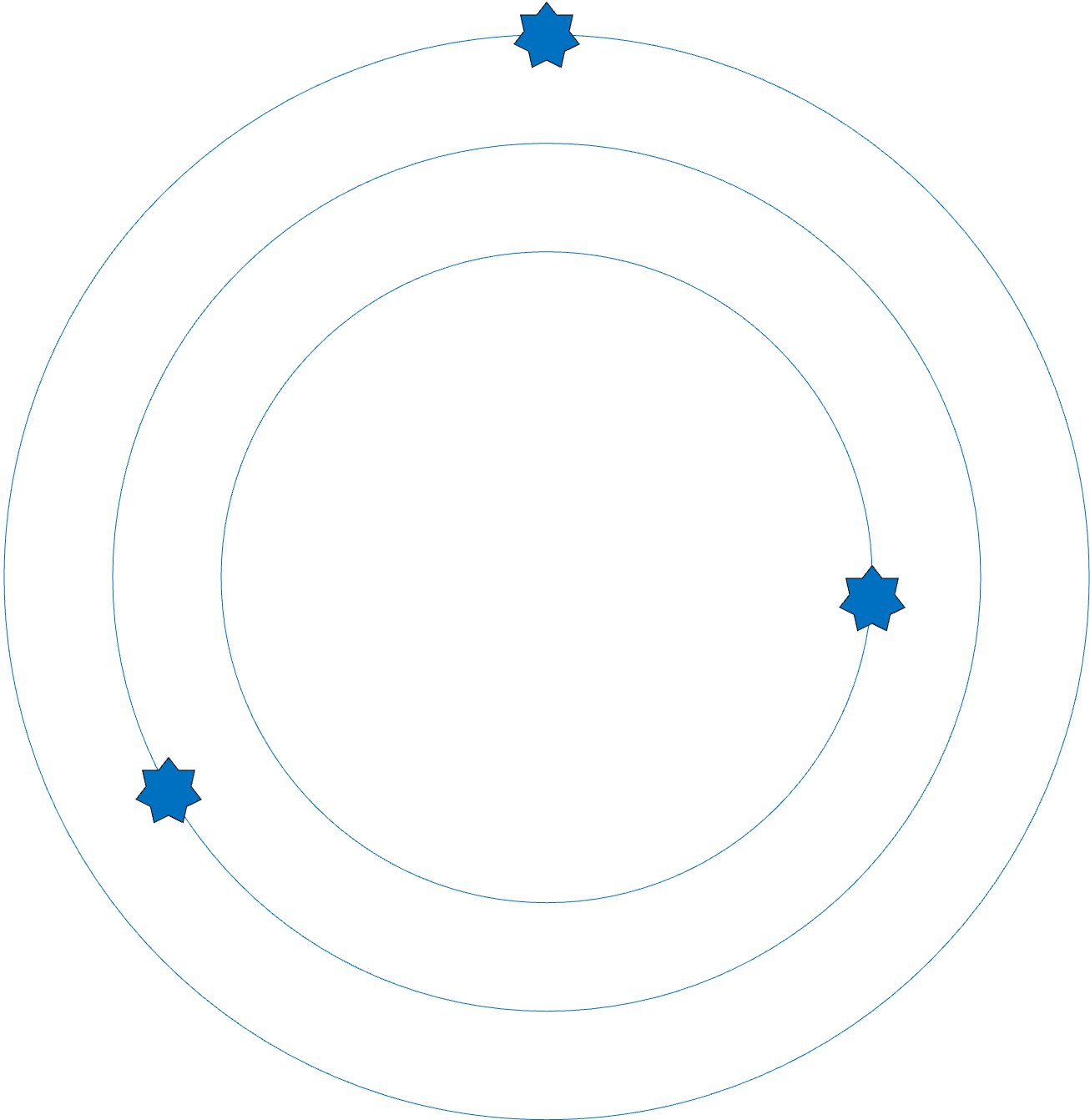

Neutral
Supportive
SSSC
Isotonic
Neutral taste
Supports fat metabolism and thus performance development.
Single-source slow carb
Isotonic drink with carbohydrate source.
What our customers say
based on +222 reviews

Targeted fat burning training.
With our GRUNDLAGE product you can specifically train your fat burning metabolism. This training is often referred to as Zone 2 training. The aim is to train persistently with low insulin levels in order to improve aerobic capacity.
Fasting training is only recommended for a maximum of 45 minutes due to limited energy reserves. With our product you can train specifically in the aerobic area for up to 2 hours.
In popular sports, this training can also be used specifically to reduce body fat. This training also improves many vital signs.
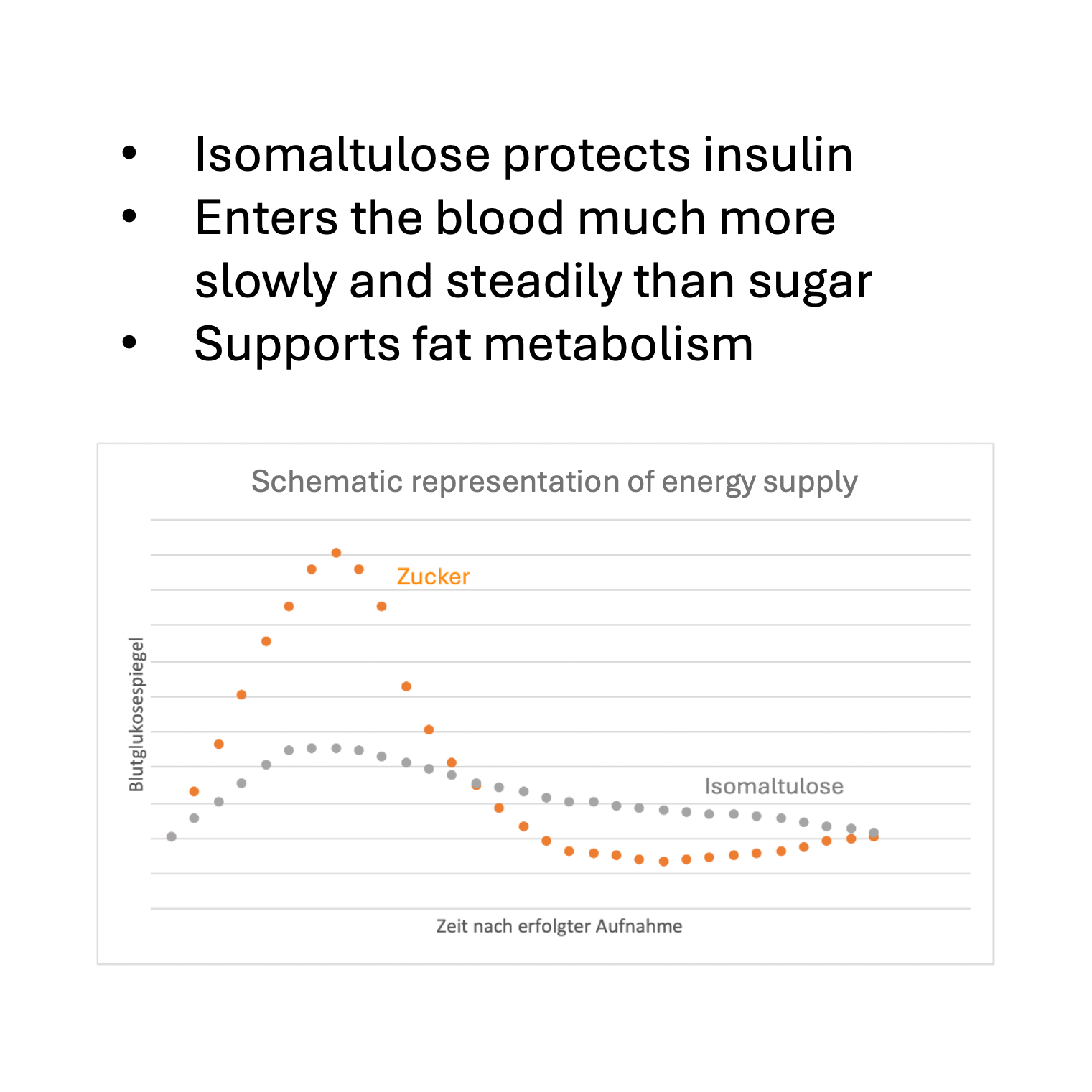
Turbo for fat burning
Isomaltulose (Palatinose™) is a special disaccharide that only increases blood sugar by an average of 20% after consumption. The increase in insulin, however, is significantly reduced compared to household sugar. This makes isomaltulose a turbo booster for fat burning. The carbohydrates provide the necessary atoms for fat burning and the low insulin only has a minor impact on fat burning.
To the productHigh-quality ingredients
We use a few, high-quality ingredients to specifically support basic training. This saves glycogen stores and improves tolerability. Only ingredients that you really need.
isomaltulose
Sodium chloride
Acidifier
We use a few, high-quality ingredients to specifically support basic training. This saves glycogen stores and improves tolerability. Only ingredients that you really need.
Let customers speak for us
Frequently Asked Questions
We are happy to answer your individual questions about the products. Below we have compiled the most frequently asked questions and their answers. If you cannot find an answer, please feel free to contact us.
How good is the solubility of the products?
The products are characterized by a high solubility due to their composition. The powder dissolves in the prescribed dosage within a few minutes and leaves no lumps or crumbs. The solution is completely colorless and does not leave any discoloration in drinking bottles or similar.
How do the products taste?
We use glucose sources in different compositions and concentrations. Therefore, the products with higher doses taste a little sweeter than the products with lower doses. The salt works together with the citric acid to create a pleasant, slightly sour taste (slightly lemony) that is well tolerated over several hours.
Do I need extra salt if I sweat a lot?
Why are there no vitamins included?
In the area of antioxidants, vitamins are counterproductive in stressful situations when it comes to achieving adaptations in performance. Antioxidants suppress oxidative processes in the body that are necessary for adaptations. Other vitamins make no sense in a targeted sports diet. They are usually not absorbed in stressful situations or they disrupt the metabolism. For this reason, we have dispensed with any vitamins as additives.
Why are there no other minerals included besides salt?
All other minerals are not necessary in the specific stress situation and are not absorbed in the intended form. There is also a risk that these minerals may be useful in a single dose, but can lead to an overdose over several hours. For this reason, we completely avoid adding minerals. Magnesium, for example, has to be stored in the form of a depot over several days anyway. Acute supply in the stress situation therefore makes no sense at all.
Example potassium:
Potassium and magnesium complement each other in their effects. A maximum of 150mg of potassium should be consumed per 750ml (one drinking bottle). If we calculate this over a long distance of 12 hours with one drinking bottle each, that means that the athlete would consume a total of 1800mg of potassium. That is then combined with 100mg of magnesium per hour, which would mean that the total intake would be 1200mg. This combination is very likely to have a laxative effect. In addition, potassium can lead to vomiting and nausea in large quantities. But taking potassium during exertion makes no sense at all. Potassium is necessary for building up glycogen stores and is stored with them. The release of the necessary potassium during exertion occurs in conjunction with the glycogen stores. So with proper preparation, there is enough potassium stored in the body. The same applies to magnesium. The depot is important here. Intake during exertion carries the risk of having a laxative effect and only putting additional strain on the stomach and intestines. That is why we do not use these additives.
Why are there no proteins included?
Proteins have an anabolic effect and are also used to generate energy during exercise. However, there are sufficient physical reserves to make these proteins available in small quantities. The substances that are important for energy are dextrose, fructose and sodium. We have limited ourselves to these, as we work specifically in stressful situations. Using proteins for regeneration makes sense and should be done with a readily available protein source in a protein:carbohydrate ratio of 1:5.
Are the products anti-doping compliant?
Cologne List® - our voluntary commitment to clean sport
Our product SportBrennstoff GRUNDLAGE is on the Cologne List® for products with a minimized doping risk.
The Cologne List® is an initiative for doping prevention and lists food supplements (NEM) that have been tested for selected doping substances by a laboratory that is a world leader in NEM analysis for doping substances.
As a partner of the Cologne List®, we ensure greater transparency in a very heterogeneous market and support athletes, teams, clubs and associations in assessing these products.
The Cologne List® is not only an indispensable partner in elite and competitive sports, but also for recreational and amateur athletes, because who would want to use products that may contain prohibited substances and thus pose a health risk?
Why should I add LOAD from the start to more than 2 hours of basic training?
The classification of products into the stress ranges provides a guideline for differentiation. However, the energy supply is ultimately decisive for the use of a product depending on the duration and intensity. The glycogen stores are the limiting factors.
With a total glycogen reserve of around 2,600 kcal, 150g / 600 kcal are in the liver and around 500g / 2,000 kcal are in the muscles. With an hourly consumption of between 600 kcal and 800 kcal in the area of zone 1 to zone 2, the liver glycogen is roughly used up after one hour. The muscle glycogen stores are still about half full even after 2 hours with a supply of 30g of carbohydrates per hour.
However, in the first step, the glycogen stores from the liver (150g, 600 kcal) are activated. To activate the glycogen stores in the muscles (approx. 500g, 2,000 kcal), the muscles need more intensive exercise. This means that these glycogen stores are not activated as strongly in zone 2 (fat burning training). This means that more than 2 hours of fat burning training with 30g of carbohydrates per hour also leads to an increased feeling of exertion.
This is also the reason why a fasting run for longer than 1 hour makes no sense. Then the liver's glycogen stores are used up and the muscle glycogen would have to be activated.
Fat burning always occurs in combination with glycogen burning. Fat burning requires atoms from glycogen burning to work efficiently.
Now you want to do basic training for over 2 hours. To do this, however, you want to avoid the feeling of strain as much as possible and be well supplied with energy. The energy supply plays a major role here and from the start you should therefore also provide the appropriate amount of exercise. This protects the liver glycogen stores (and also the muscle glycogen stores). In addition, the body gets used to the energy supply from the outside with exercise (glucose/fructose). For this, I used a special composition of the various glucose sources during exercise (we are the only ones who do this) and combined it with 1:1 fructose. The fructose goes directly to the liver as a replacement for liver glycogen.
However, if you are exercising in a controlled, relaxed manner and there are no peaks in the load, it would also be possible to work with a base of 60g (double portion). This is best done on an exercise bike/smart trainer, where the load can be controlled extremely well. This would result in particularly good fat metabolism training. It would definitely make sense.
























